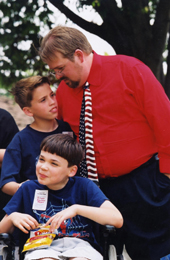CB05-FF.08 June 10, 2005 Printable PDF Version (70K) |
||||||||
Father's Day: June 19The idea of Father’s Day was conceived by Sonora Dodd of Spokane, Wash., while she listened to a Mother’s Day sermon in 1909. Dodd wanted a special day to honor her father, William Smart, a widowed Civil War veteran who was left to raise his six children by himself on a rural farm. June was chosen for the first Father’s Day celebration — proclaimed for June 19, 1910, by Spokane’s mayor — because it was the month of William Smart’s birth. The first presidential proclamation honoring fathers was issued in 1966 when President Lyndon Johnson designated the third Sunday in June as Father’s Day. Father’s Day has been celebrated annually since 1972 when President Richard Nixon signed the public law that made it permanent. |
||||||||

How Many Fathers?66.3 millionEstimated number of fathers across the nation today. (From unpublished data.) 26.5 million Among these —
2.3 million
Among these fathers —

Mr. Mom98,000Estimated number of “stay-at-home” dads. These are married fathers with children under 15 years old who have remained out of the labor force for more than one year primarily so they can care for the family while their wives work outside the home. Among these stay-at-home dads: |
Remembering All DadsNeckties lead the list of Father’s Day gifts. A good place to buy dad a tie or a shirt might be one of 10,416 men’s clothing stores around the country.Other items high on the list of Father’s Day gifts include those you may find in dad’s toolbox, such as hammers, wrenches and screwdrivers. You could buy some of these items for dad at one of the nation’s 14,755 hardware stores or 5,280 home centers. 23,018 Nearly 69 million Americans have participated in a barbeque in the last year [PDF] — it’s probably safe to assume many of these barbeques took place on Father’s Day. Nearly 95
million Fifty percent of all Father’s Day cards are purchased for dads.
Nearly 20 percent are purchased for husbands, with the remaining bought
for grandfathers, sons, brothers, uncles and “someone special,”
among other categories. |
|||||||
|
Child-Support4.6 millionNumber of fathers who provid child support. All in all, 84 percent of child-support providers are men, who provide median payments of $3,600 annually. |
|||||||
| Following is a list of observances typically covered by the Census Bureau Facts for Features series: | ||||||||
|
|
|||||||
| Individual source links for
each statement herein may be accessed on the Internet at The photos
herein may be downloaded and are available free for your use in all
print and broadcast products. Editor’s note: Some of the preceding data were collected in surveys and, therefore, are subject to sampling error. Questions or comments should be directed to the Census Bureau’s Public Information Office at (301) 763-3030; fax (301) 457-3670; or e-mail <pio@census.gov>. |
||||||||
